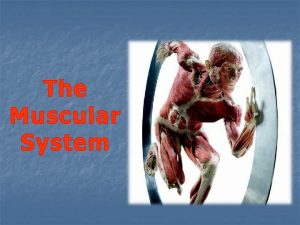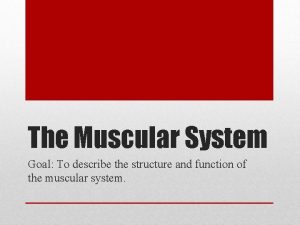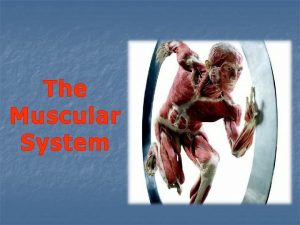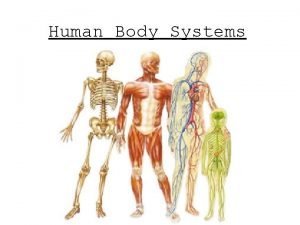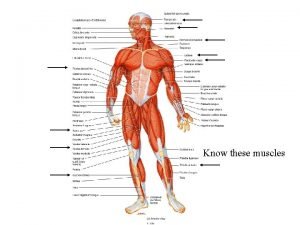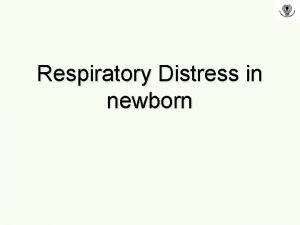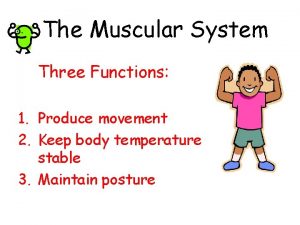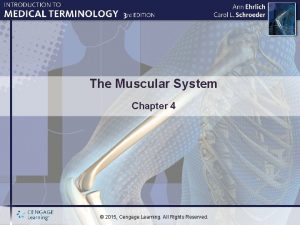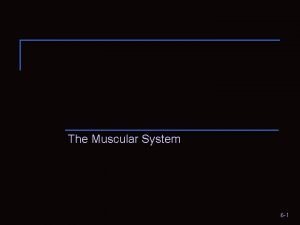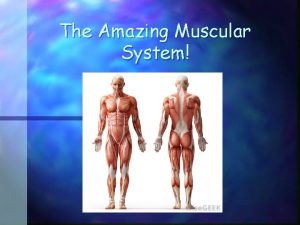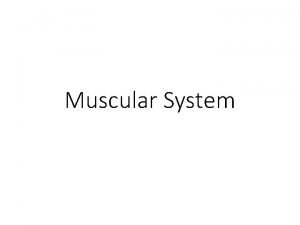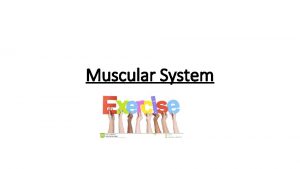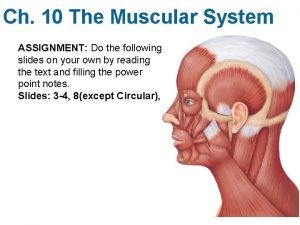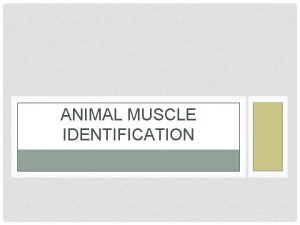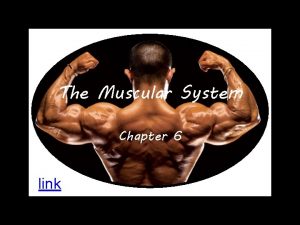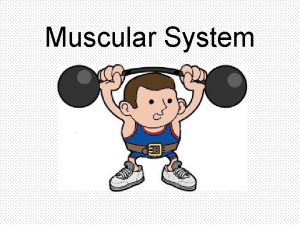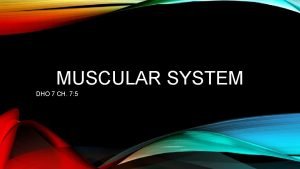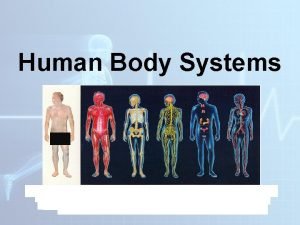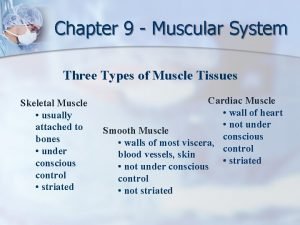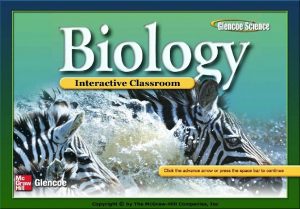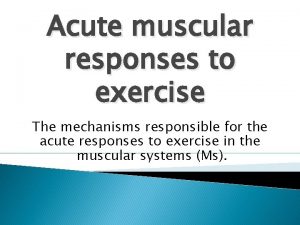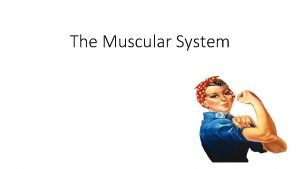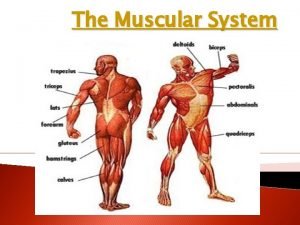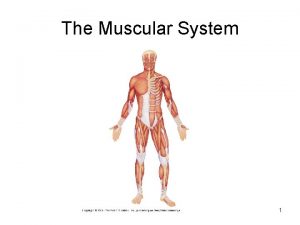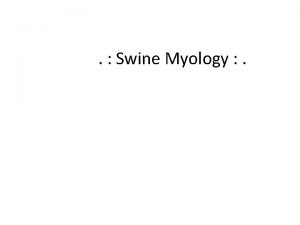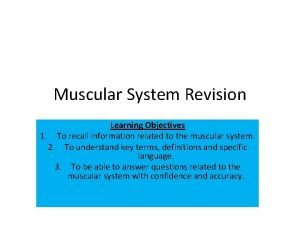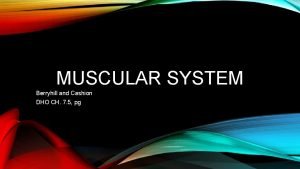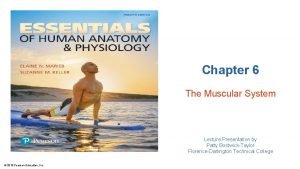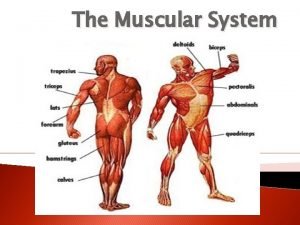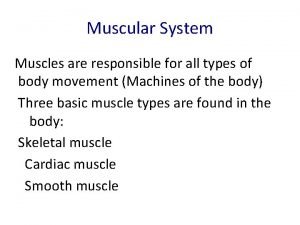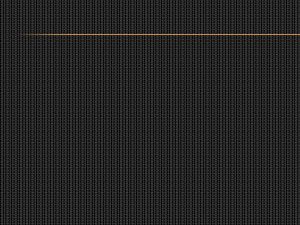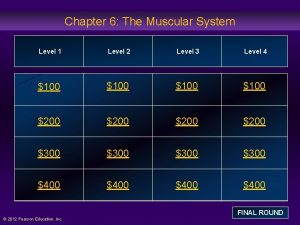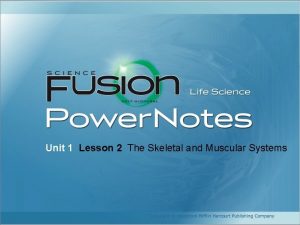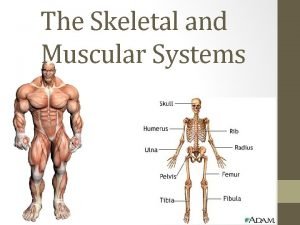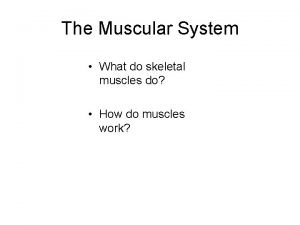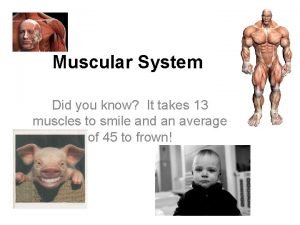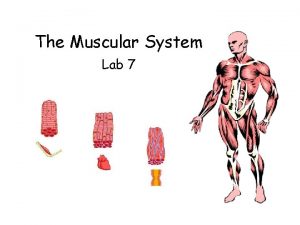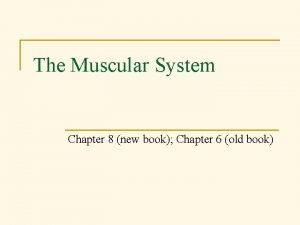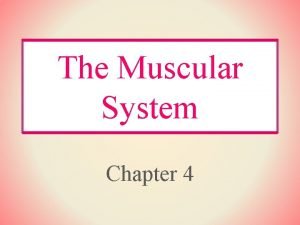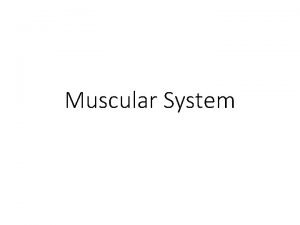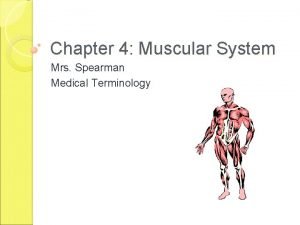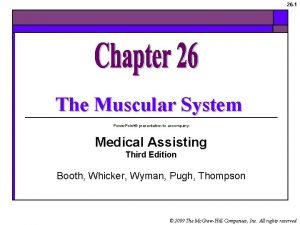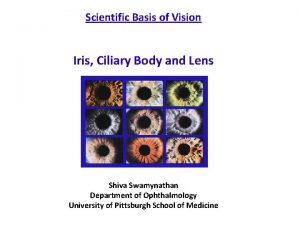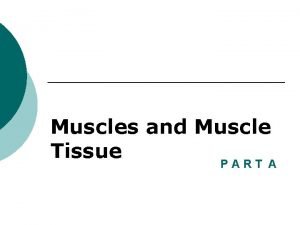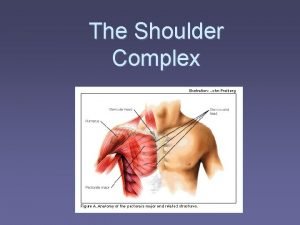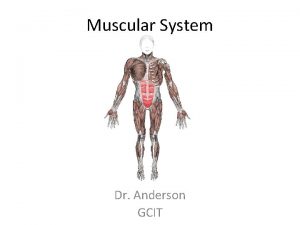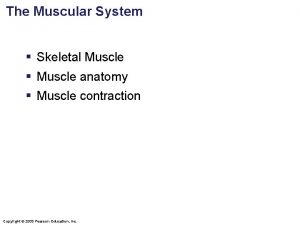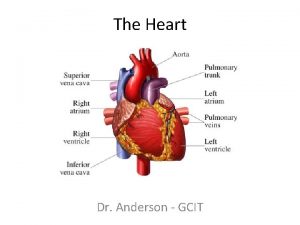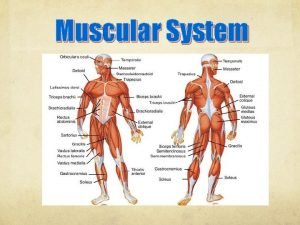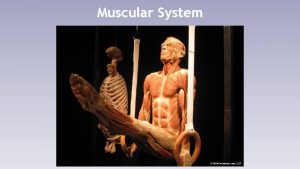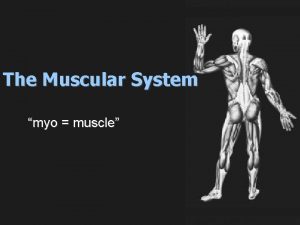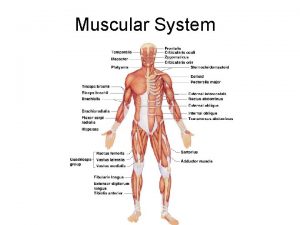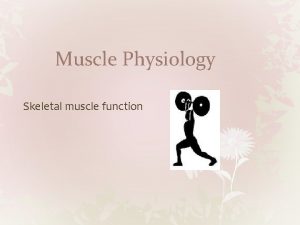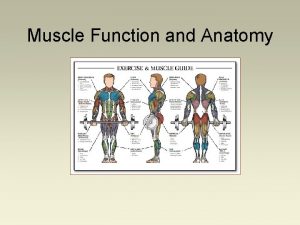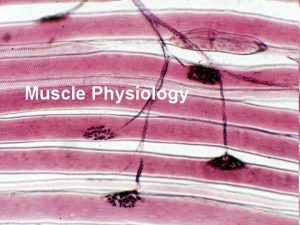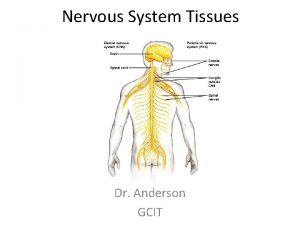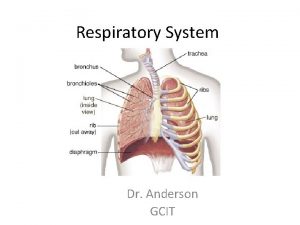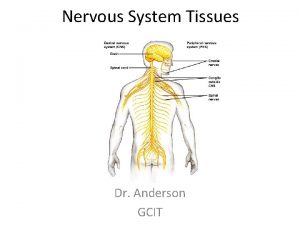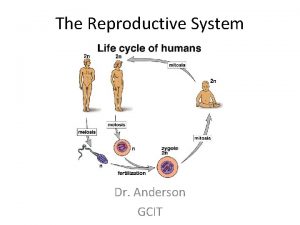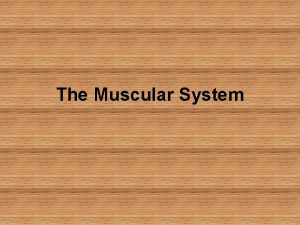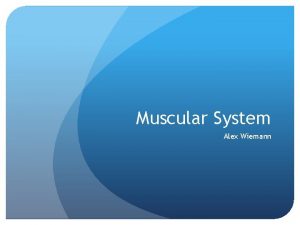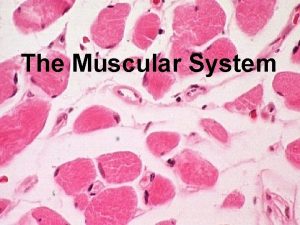Muscular System Dr Anderson GCIT Function Muscle is































































- Slides: 63

Muscular System Dr. Anderson GCIT

Function • Muscle is a collective term for tissue that causes movement of the body, or materials through the body • Muscle can also serve other functions such as – Stabilizing the body – Producing heat

Muscle Tissue • Three main types of muscle – Skeletal – attaches to skeleton and enables body movement striated, voluntary – Smooth – lines body cavities to move fluids throughout the body – smooth, involuntary – Cardiac – makes up the heart – striated, involuntary

Physiology • Muscles function by converting the energy stored in ATP into mechanical energy that the muscle can use to contract – muscles only expend energy to get shorter

Muscle Characteristics • Excitability – the muscle’s ability to react to a stimulus • Contractility – the ability to shorten forcibly • Extensibility – the ability to be stretched • Elasticity – the ability for a muscle to return to its pre-stretched length

Skeletal Muscle Anatomy • There are roughly 640 skeletal muscles in the human body • Each one is a discrete unit (organ) of contraction, separated by membranes and served by – One major nerve – One artery – One to a few veins

Muscle Connections/Separations Individual muscles are separated by sheaths of connective tissue • Epimysium – surrounds entire muscle • Perimysium and fascicles – perimysium surrounds bundles of muscle fibers (fascicles) • Endomysium – very thin sheath of tissue that surrounds each muscle fiber (cell)

Muscle Sheaths

Skeletal Origins and Insertions • Skeletal muscles are connected to bone in at least two places • Origin – end connected to the immovable bone • Insertion – connected to moveable side • Direct – Epimysium of muscle is fused directly to the periosteum of bone (less common) • Indirect – The connective tissue connects to bone via a tendon (more common)

Direct vs. Indirect Muscle Attachment Direct Attachment (to skull) Indirect Attachments

Muscle Fiber Anatomy • • Sarcolemma – cell membrane of muscle cell Sarcoplasm – cytoplasm of muscle cell Glycosomes – granules of stored glycogen Myoglobin – red pigment that can store O 2 in muscles

Myofibrils • Complex organelle composed of bundles of myofilaments in a muscle fiber (appear banded in skeletal muscle)

Sarcomere • The smallest contractile unit of the muscle • Composed of protein filaments (myofilaments) that shorten the muscle upon stimulation • Here’s where it gets complicated…. .

Thick and Thin Filaments • Thick filaments (myosin) – contain globular myosin “heads” that will bond to thin filaments during muscle contraction • Thin filaments – composed of: – Actin – the structural protein that provides tensile strength – Troponin and Tropomyosin -proteins that regulate muscle contraction • Titin – allows for extensibility and elasticity during and after contraction

Ultrastucture of Muscle Fibrils Thick Filament (Myosin) Titin Thin Filament (Actin)

Sarcomere Components

Muscle Contraction • Thick filament heads and thin filaments link and form cross-bridges – The heads swivel and pull the opposing thin filaments of the sarcomere together – Helpful video! – http: //www. youtube. com/watch? v=ELyo. JZom 5 N 0

Regulatory Proteins • Tropomyosin – bound within the actin filaments and block myosin-binding sites (when muscle is relaxed) • Troponin – helps stabilize actin and binds Ca+ ions

Sarcoplasmic Reticulum • Specialized smooth endoplasmic reticulum (s. ER) that surrounds each myofibril – Most run longitudinally along the length of the cell – However, between the thick filaments and the Z disc, they form pairs of terminal cisternae • This organelle is critical in that it stores and releases Ca+ ions, which are the triggers for muscle contraction

T- Tubules • An invagination of the sarcolemma – located between the terminal cisternae in each sarcomere • The structure of 2 Terminal cisternae divided by t-tubules is called a TRIAD • Why is all of the surface area in triads necessary?

Triads Triad

The Sliding Filament Model (Sum-up) • Thin filaments are “captured” by the myosin heads of the thick filaments by forming crossbridges • As the myosin heads swivel, they ratchet the thin (actin) filaments towards the H-line • This shortens the sarcomeres, and in turn the entire muscle, causing movement

Muscle Flexing • In order for muscles to flex: – They must be stimulated by nerves (or chemicals) – An action potential must propagate (travel) along the sarcolemma – Ca+ ions must increase in concentration, causing the filaments to slide past one another

Muscle Innervation (Motor Nerves) • Motor nerves from the spinal cord innervate the muscle to communicate with the muscle fibers • The fibers do not touch but come exceedingly close (1 -2 nm apart) forming the synaptic cleft

Synaptic Cleft (Neuromuscular Junction) • From the nerve terminal, a neurotransmitter called acetylcholine (ACh) is released • ACh is then picked up by receptors on the sarcolemma

Electrical Gradient • Normally, the sarcolemma is polarized (more negative on the inside than the outside) • When ACh binds to it receptors, channel proteins let ions (Ca+ and K+) pass • More Ca+ ions stream into the cell than K+ ions stream out, therefore the inside of the cell becomes less negative – this is called depolarization

Synaptic Cleft Arrangement

Helpful Video • http: //www. youtube. com/watch? v=kv. MFd. Nw 35 L 0

Synaptic Cleft • From the nerve terminal, a neurotransmitter called acetylcholine (ACh) is released • ACh is then picked up by receptors on the sarcolemma

Electrical Gradient • Normally, the sarcolemma is polarized (more negative on the inside than the outside) • When ACh binds to receptors, it opens channel proteins which lets ions (Ca+ and K+) pass • More Ca+ ions stream into the cell than K+ ions stream out, therefore the inside of the cell becomes less negative – this is called depolarization

Depolarization- Successive Steps 1. Action potential (nerve impulse from motor neuron) reaches the muscle fiber(s) 2. ACh is released, opening Ca channels (ACh is quickly degraded by acetylcholinesterase 3. The “local” depolarization from the neuron (end plate depolarization) depolarizes adjacent membrane areas 3. Then voltage-gated ion channels allow Ca+ ions to enter 4. This action potential is the propagated through the sarcolemma, opening up more channels

Depolarization- Successive Steps • 5. Voltage-dependent gates open, and more Ca+ floods through the sarcolemma • 6. The influx of Ca+ leads to muscle contraction by interacting with tropomyosin, freeing the myosin binding sites

Repolarization • K+ channels open, which allows K+ to flood out of the cell, restoring the negative conditions inside • How do we restore the electrochemical balance of the cell?

Sodium-Potassium Pump • ATP-dependent protein “pump” that restores the ionic concentration that was present before depolarization

Excitation-Contraction Coupling • Calcium ion influx (through T-tubules and into terminal cisternae) • Calcium binds to troponin and removes the blocking action of tropomyosin, allowing myosin to bind to the thin (actin) filaments • Myosin cross-bridges with actin, leading to contraction

Let’s Sum Up • http: //www. youtube. com/watch? v=70 Dy. Jww Fnk. U

Muscle Innervation • The single motor nerve that innervates a muscle can contain hundreds of motor neurons • A motor unit is a motor neuron and all of the muscle fibers that it serves – the more motor units, the larger the force (more fibers contract) – Which muscles might have small motor units? Large motor units?

Motor Unit

Strength of Contraction • Increasing strength can be due to – Increased frequency of stimuli • The less time between nerve stimulation, the greater the force of flexion due to Ca being left over in the muscle – Increased number of stimulated motor units • The more motor units stimulated, the greater the force of flexion

(Frequency of Stimuli) Twitch Latent – Ca floods in Contraction – Myosin heads pull and make sarcomeres shorter Relaxation – muscle activity stops as ions are replaced to normal concentrations

Contraction Strength • How is the strength of a contraction controlled? • The size/number of motor neurons stimulated – Small neurons (and therefore small muscles) are most excitable and fire first – Large neurons are the least excitable and fire last (only used when strongest contractions are needed)

Isotonic vs Isometric Contraction • Isotonic – muscle moves when flexed – Concentric – muscle moves and shortens – Eccentric – muscle moves while lengthening • Isometric – muscle flexes, but does not shorten or lengthen

Muscle Physiology • Where do muscles get the energy to flex, and keep flexing?

Muscle Metabolism • ATP!! – Provides the energy needed for cross bridge movement and detachment (of myosin heads), but short supply in most muscles • ATP-ADP-ATP cycles rapidly by: – Creatine phosphate phosphorylation – Anaerobic respiration (burning sugar without O 2) – Aerobic respiration (burning sugar with O 2)

Creatine Phosphate • Another high-energy molecule that converts ADP to ATP by direct phosphorylation via an enzyme called creatine kinase ADP + creatine phosphate creatine kinase ATP + creatine

Rigor Mortis • Lack of ATP after death causes contractures, where myosin heads cannot detach from the actin filaments, locking up the muscle until muscle proteins start to break down

Length vs. Force • The strength of a muscle contraction varies drastically over its length – Strongest from 80 -120% of its resting sarcomere length

Velocity of Contraction • “Fast twitch” fibers – contract rapidly – Large fibers that depend on stored glycogen reserves (does not depend on delivery of nutrients) – Low myoglobin – Tires quickly • “Slow fibers” – contract slowly – Uses nutrients delivered from blood, therefore rich capillary supply – High myoglobin – High endurance

Smooth Muscle • Different microstructure, but similar function as skeletal muscle • Flexing is under control of the autonomic nervous system, but also under the control of local chemistry

Smooth Muscle • Lines the: – Stomach and intestines – Blood vessels – Lungs – Urinary system – Reproductive organs

Muscle Sheets • In Digestive organs, smooth muscle sheets are arranged at 90 degree angles to each other • What will this lead to during flexing? http: //www. youtube. com/watch? v=pf. NYbz. GEg. O 8

Smooth Muscles • Smooth Muscle Cells are: – Uninucleate – Spindle-shaped – Much narrower and shorter than skeletal muscle cells – Calveoli instead of Ttubules – No sarcomeres!

Smooth Muscle Sheaths • Only a small amount of endomysium runs between smooth muscle cells • This network is also perfused and innervated Longitudinal section Transverse Section

Distribution • Most smooth muscle occurs in walls of organs that transport fluids through the body (liquids and gases) • Many organs have muscle cells arranged in 2 layers that run perpendicular to each other – Why?

Peristalsis • Rhythmic, alternate contractions between muscle sheets in digestive system • By alternating contractions, the bolus of food (or waste) can be moved through the intestines • http: //www. youtube. com/watch? v=o 18 Uyc. W Rsa. A

Stimulation • Smooth muscles lack synaptic clefts, but neurotransmitter is released in the general area of muscle cells by nerve bundles called varicosities

Contraction – Smooth vs. Skeletal • Thick and thin filaments arranged diagonally • Calmodulin instead of troponin complex • Thick filaments have myosin heads across their entire length

Anchoring of Smooth Muscle • Intermediate Filaments – non-contractile filaments that anchor to dense bodies which are attached to adjacent sarcolemmas – Why is this important?

Smooth Muscle Cell Contraction vs. Extension • Ca++ binds to calmodulin, which activates myosin kinase which phosphorylates the myosin heads, activating them • Myosin is then able to form cross-bridges with actin, and contract the muscle

Response to Stimuli • Smooth muscle takes up to 30 times longer to react to a stimulus than skeletal muscle • Smooth muscles may stay in a contracted (flexed) state for long periods, as myosin heads remain attached to actin filaments for longer periods

Nerve- Based Contraction • Contraction of smooth muscle is still due to the release of neurotransmitters – Highly dependent on receptors for neurotransmitters – E. g. norepinephrine relaxes smooth muscle in bronchioles

Response to Stretch • Stress-relaxation response – abrupt stretches may cause muscle to contract, but long slow stretches may allow the muscles to extend – Examples?

Stretch and Tension • Different arrangement of filaments allows smooth muscle to be stretched quite and still contract strongly • Example?
 Difference between strength and endurance
Difference between strength and endurance What is the primary function of the muscular system
What is the primary function of the muscular system Main function of muscular system
Main function of muscular system Whats the function of the muscular system
Whats the function of the muscular system 3 function of muscular system
3 function of muscular system Different types of muscle cells
Different types of muscle cells What muscle fibers run in circles around your eye
What muscle fibers run in circles around your eye Function of muscular tissue
Function of muscular tissue Role of muscle tissue
Role of muscle tissue Silver anderson score
Silver anderson score Three functions of the muscular system
Three functions of the muscular system Chapter 4 the muscular system
Chapter 4 the muscular system Unit 6:5 muscular system
Unit 6:5 muscular system Amazing facts about the muscular system
Amazing facts about the muscular system Root word muscle
Root word muscle Muscular system label
Muscular system label Chapter 6 the muscular system
Chapter 6 the muscular system Muscular system head and neck
Muscular system head and neck Sheep muscular system
Sheep muscular system Navigating the body skeletal system #1
Navigating the body skeletal system #1 Chapter 6 the muscular system figure 6-9
Chapter 6 the muscular system figure 6-9 Whats the muscular system
Whats the muscular system Chapter 7:5 muscular system
Chapter 7:5 muscular system Aerobic respiration exercise
Aerobic respiration exercise Sarcomore
Sarcomore Active muscle
Active muscle Chapter 32 section 3 the muscular system
Chapter 32 section 3 the muscular system Muscular system response to exercise
Muscular system response to exercise Whats the muscular system
Whats the muscular system Muscles of the body
Muscles of the body Dorsifelxion
Dorsifelxion Muscular system
Muscular system Superficial muscular system
Superficial muscular system Muscle
Muscle Muscular system learning objectives
Muscular system learning objectives Chapter 7:5 muscular system
Chapter 7:5 muscular system Chapter 6 the muscular system
Chapter 6 the muscular system Cengage chapter 4 answers
Cengage chapter 4 answers What are the major functions of the muscular system
What are the major functions of the muscular system Muscular system means
Muscular system means Musculo fusiforme
Musculo fusiforme Chapter 6 the muscular system
Chapter 6 the muscular system Chapter 6 the muscular system
Chapter 6 the muscular system Chapter 10 the muscular system
Chapter 10 the muscular system Lesson outline lesson 2 the muscular system answer key
Lesson outline lesson 2 the muscular system answer key Muscle diagram
Muscle diagram Skeletal and muscular system
Skeletal and muscular system Named
Named Major muscles
Major muscles Muscle system
Muscle system Muscle
Muscle Whats the job of the muscular system
Whats the job of the muscular system Muscle diagram
Muscle diagram Chapter 8 the muscular system
Chapter 8 the muscular system Cardiac muscle tissue
Cardiac muscle tissue Sarcolemma definition
Sarcolemma definition Myalgia is abnormal softening of muscle tissue.
Myalgia is abnormal softening of muscle tissue. Skeletal and muscular system
Skeletal and muscular system Muscular system
Muscular system Thyroidoctomy
Thyroidoctomy Blood supply to the pupil
Blood supply to the pupil Muscle tissue function
Muscle tissue function Subscapularis muscle action
Subscapularis muscle action Upper leg muscles
Upper leg muscles

